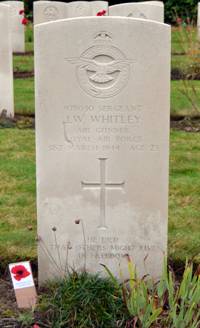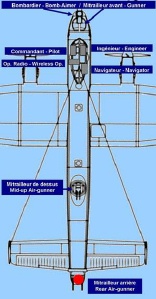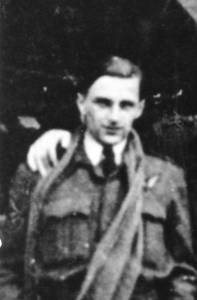Témoignage de Brenda Collins, la soeur de James Whitley, le mitrailleur arrière
Le Lancaster LM 425 BQ-N, en route vers sa cible, a été touché par un chasseur de nuit et s’est écrasé au barrage de la Gileppe. Le sergent James « Tony » Whitley avait pris sa fonction en tant qu’operateur radio, au début de l’année 1940. Comme il n’obtenait pas la vitesse demandée pour le codage en morse, il dut abandonner la formation radio. Il s’est ensuite proposé comme mitrailleur à bord.
Sa sœur Brenda Collins disait : « Tony a été à l’école Grammar de Chester et son sport favori était le cricket. Après l’école, il a intégré l’école d’Architecte à Liverpool pour suivre les traces de son père. La guerre a éclaté et comme il était passionné de tout ce qui touchait à l’aviation, il s’est présenté à la RAF. En effet, depuis son jeune âge, il collectionnait et collait dans un cahier des photos et descriptions des premiers avions. Tony était un garçon tranquille avec beaucoup d’humour.
Sa sœur Brenda Collins disait : « Tony a été à l’école secondaire de Chester et son sport favori était le cricket. Après l’école, il a intégré l’école d’Architecte à Liverpool pour suivre les traces de son père. La guerre a éclaté et comme il était passionné de tout ce qui touchait à l’aviation, il s’est présenté à la RAF. En effet, depuis son jeune âge, il collectionnait et collait dans un cahier des photos et descriptions des premiers avions. Tony était un garçon tranquille avec beaucoup d’humour.
Il passait son temps à grimper les collines avec son copain Donald Brown qui était entré au service du « Bomber Command » et fut tué 2 semaines avant Tony. Quand il était en congé, nous nous promenions beaucoup dans la nature et il me racontait la tension qu’il avait lorsqu’il volait et jetait des bombes sur des inconnus. Comme la plupart des jeunes pilotes, il possédait une mascotte, un jouet du nom de Leo.
Les premières expériences de John Tony Whitley avec la guerre se sont passées à Swindon. Il avait rencontré des hommes de l’Armée d’expédition britannique et appris la nouvelle de l’évacuation de Dunkerque.
Le père de Tony, J.E. Whitley, qui était capitaine des « Royal Engineers » a reçu une lettre du sergent Keirle, après la guerre.
Les premières expériences de James Tony Whitley avec la guerre se sont passées à Swindon. Il avait rencontré des hommes de l’Armée d’expédition britannique et appris la nouvelle de l’évacuation de Dunkerque. Le père de Tony, J.E. Whitley, qui était capitaine des « Royal Engineers » a reçu une lettre du sergent Keirle (opérateur radio), après la guerre.
Le sergent Keirle se rappelle encore du briefing habituel de mars 1944. « L’objectif était Nürnberg. Nous avons décollé vers 21h30 et tout semblait calme jusqu’à ce que nous approchâmes
la côte où l’ennemi se trouvait. Nous apercevions les feux des projecteurs de l’ennemi, mais nous avons réussi à les esquiver. Jimmy avait aperçu un chasseur et nous avons alors effectué les
manœuvres courantes d’évasion. Le chasseur ne nous a pas attaqués, mais continua à voler en-dessous de nous. Durant ce vol, j’ai éteint l’intercom pour écouter l’émission de minuit de la base.
Deux minutes plus tard, j’ai senti un choc. J’ai immédiatement remis l’intercom, juste à temps pour entendre le mitrailleur de dessus (Upton) m’informer que le moteur à bâbord extérieur
et l’aile étaient en feu. Le commandant (Jefferies) nous a donné l’ordre de nous préparer à sauter. Après avoir attaché mon parachute, j’ai ouvert la porte et vu que Jimmy Whitley et George Upton
avaient également endossé leur parachute. Ensuite, le bombardier (Jeffrey) nous informa que les bombes ne voulaient pas se détacher.
Après j’ai appris qu’il avait tout de même réussi à jeter les bombes. Je me trouvais à ce moment dans la coupole du mitrailleur et je voyais que le moteur extérieur et la moitié de l’aile se déchiraient. Le pilote ordonna immédiatement une sortie de secours et ajouta qu’il ne parvenait plus à tenir l’avion sous contrôle.
L’appareil glissait vers bâbord et perdait de l’altitude. Nous étions piégés et ne pouvions rien faire à cause de la force de traction énorme provoquée par l’aile droite endommagée. Je perdis connaissance, tout comme le bombardier et le mitrailleur de dessus. Je me rappelle vaguement que je tirais à la corde de mon parachute mais que je n’ai repris connaissance qu’après avoir touché brutalement le sol. Je me suis rendu compte que je tenais en main un morceau de l’avion, le dôme du cockpit. J’ai eu des difficultés à me dégager de mon harnais et de ma veste de sauvetage, ainsi que des pièces de l’épave qui m’entouraient.
Je ne parvenais pas à me tenir debout. Après quelques heures, des soldats allemands m’ont repéré et sont restés près de moi jusqu’au matin. Un officier est venu m’interroger sur l’opération que je menais, l’escadron, etc. mais je lui ai fait savoir que je ne le comprenais pas. Après, j’ai voyagé à bord d’un sidecar d’une moto, ce qui allait être le voyage où j’ai le plus souffert et le plus rude de mon existence. On m’a déposé dans un coin près d’un pont.
Plus tard, j’ai été rejoint par le bombardier Jeffrey et le mitrailleur de dessus Upton, les seuls rescapés de l‘avion. Nous avons été amenés dans un hôpital pour prisonniers de guerre à Aix-la-Chapelle. J’y suis resté tandis que les deux autres garçons, qui n’étaient pas blessés, ont été envoyés dans un Stalag. J’avais la colonne verticale brisée, la cheville gauche fracturée, la rate déchirée, une blessure au genou gauche et diverses contusions et coupures.
Je suis resté à l’hôpital d’Aix-la-Chapelle jusqu’au soir du 11 avril quand le RAF attaquait la station avoisinante. L’hôpital a été touché et je suis resté plusieurs heures sous les décombres. J’ai ensuite été amené à Bonn où j’ai pu, après 2 semaines, entrer en contact avec deux anglais. J’ai pu quitter l’hôpital fin juin, pas entièrement guéri mais trop valide pour occuper un lit allemand. On m’a envoyé dans un centre d’interrogation à Frankfurt et puis à Stalag Luft 7 jusqu’au 19 janvier 1945.
Ce jour, nous marchions vers l’Allemagne, loin des Russes. Nous avions parcouru 550 km en un mois et vivions de ce que nous trouvions ou rassemblions sur place. Finalement, nous sommes arrivés à Stalag 3A, à 50 km au sud-est de Berlin. Nous y sommes restés jusqu’au 6 avril, date à laquelle des Russes nous ont délivrés. Les difficultés n’étaient pas terminées pour autant, car les Russes nous ont obligés à combattre avec eux pour délivrer Berlin. Comme tout le monde refusait, ils nous ont laissé sans nourriture et dans un camp surveillé par des gardes armés. J’ai pu me sauver une semaine plus tard, ensemble avec 4 autres soldats. Nous cherchions une route vers les lignes américaines à Bitterfeld. Les américains nous ont ramenés de Leipzig à Reims à bord de Dakotas, nous ont fourni des uniformes américains et renvoyés en Angleterre à bord d’un Lancaster. Le 19 mai j’étais de retour à la maison où j’apprenais la mort de mon père durant mon absence. »
Les hommes qui ont péri à bord du Lancaster ont été rapatriés depuis Saint-Trond et reposent aujourd’hui à Heverlee.
Source: Goovaerts Wim; Avro Manchester en Avro Lancaster verliezen in België, 1941-1945; De Krijger, 2005
Testimony of Brenda Collins, sister of James Whitley, rear Air-Gunner
Lancaster LM 425-BQ-N, on the way towards its target, was touched by a night fighter and crashed near the dam of Gileppe during the night of 30th to 31st of April 1944.
Sergeant James "Tony" Whitley had taken his function as wireless operator at the beginning of year 1940. As he did not obtain the speed asked for the coding in walrus, he had to stop the course. He then proposed as air-gunner on board.
His sister Brenda Collins said: "Tony was at the school Grammar of Chester and his favourite sport was the cricket. After the school, he joined architect's school in Liverpool to follow the tracks of his father. The war begun and as he was fascinated by all concerning aviation, he enlisted at the RAF.
Indeed, in his young age, he collected and stuck in an exercise book of photos and description of the first planes. Tony was a quiet boy with a lot of humour. He spent time climbing hills with his friend Donald Brown who had entered in the service of "Bomber Command" and was killed two weeks before the dead of Tony. When he was on vacation, we walked in the nature a lot and he told me the tension that he had when he flew and dropped bombs on the unknowns. As most of the young pilots, he had a mascot, a toy named Leo. "
The first experiences of John Tony Whitley with war happened to Swindon. He had met people of the British Army of expedition and heard the story of the evacuation of Dunkerque. The father of Tony, J.E. Whitley, who was captain of "Royal Engineers”, received a letter of sergeant Keirle, after the war.
Sergeant Keirle still remembers himself of the usual briefing of March, 1944. The target was Nurnberg. We took off at about 9:30 pm and everything seemed quiet until we approached the coast where the enemy was. We perceived the spotlights of the enemy, but we had managed to avoid them. Jimmy had perceived a fighter and we had then made the current operations of escape. The fighter did not attack us, but continued to fly below us. During this flight, I switched off the intercom to listen to the broadcast of midnight of the base.
Two minutes later, I felt shock. I immediately put back the intercom, just in time to hear the mid-up air gunner to inform me that the engine on the outside right and the wing were on fire. The pilot gave us the order to prepare us to jump. Having attached my parachute, I opened the door and saw that Jimmy and George had also their parachute on them. Then, the bomber informed us that bombs did not want to get loose.
Later I learnt that he had succeeded in dropping all the bombs. I was at this moment in the mid-up turret and I saw that the outside engine and half of the wing tore. The pilot ordered immediately an emergency exit and added that he did not any more succeed in holding the plane under control.
The aircraft slid towards right and lost of the height. We were trapped and could make nothing because of the strength of enormous drive provoked by the damaged right-wing. I lost consciousness, just like the bomber and the mid-up gunner. I remember myself vaguely that I fired in the rope of my parachute, but that I regained consciousness only having touched brutally the ground. I realized that I held a piece of the plane, the dome of the cockpit. I had difficulty releasing me of my harness and my jacket of rescue, as well as of parts of the wreck which surrounded me
I did not succeed in standing. After a few hours, German soldiers spotted me and stayed near me until morning. An officer came to question me about the operation that I led, the squadron, etc., but I let him know that I did not understand him. Then, I travelled aboard the sidecar of a motorcycle, what was going to be the journey where I suffered the most and the roughest of my existence. They laid me in a place, near a bridge.
Later, I was joined by the bomber Jeffrey and the mid-up air gunner Upton, the only survivors of the plane. We were brought in a hospital for war prisoners in Aachen. I stayed there whereas two other boys, who were not hurt, were sent to a Stalag. I had the broken vertical column, the broken left ankle, the torn spleen, a wound in the left knee and diverse bruises and cuts.
I stayed in the hospital of Aachen until the evening of April 11th when RAF attacked the neighbouring station. The hospital was touched and I stayed several hours under rubble. I was then brought in Bonn where I was able, after two weeks, to get in touch with two English. I was able to leave the hospital at the end of June, was not completely cured but too valid to occupy a German bed. They sent me to a center of interrogation to Frankfurt and then to Stalag Luft 7 until January 19th, 1945.
This day, we walked towards Germany, far from the Russians. We had traveled 550 km in one month and lived on what we found or collected on the spot. Finally, we arrived at Stalag 3A, at 50 km in the southeast of Berlin. We stayed until April 6th, the date in which the Russians freed us. The difficulties were not ended for all that because the Russians obliged us to fight with them to deliver Berlin. As everybody refused, they left with us without food and in a camp watched by armed guards. I was able to save myself one week later, together with four other soldiers. We looked for a road towards the American lines to Bitterfeld.
The Americans returned us of Leipzig to Reims aboard Dakotas, supplied us uniforms American and sent back in England aboard Lancaster. On May 19th I was back home where I learnt the death of my father during my absence.
The men who died aboard Lancaster were repatriated since Sint-Truiden and rest to the War Cemetery of Heverlee today.
Source: Goovaerts Wim; Avro Manchester en Avro Lancaster verliezen in België, 1941-1945; De Krijger, 2005





 Certificat de scépulture
Certificat de scépulture


